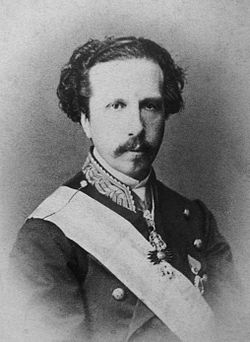Top Qs
Timeline
Chat
Perspective
Francisco de Asís, Duke of Cádiz
King consort of Spain from 1846 to 1868 From Wikipedia, the free encyclopedia
Remove ads
Francisco de Asís (Francisco de Asís María Fernando de Borbón; 13 May 1822 – 17 April 1902) was King of Spain as the husband of Queen Isabella II from their marriage in 1846 until Isabella's deposition in 1868. Francisco and his wife were double first cousins, as their fathers were brothers and their mothers were sisters. Isabella was deposed in the Glorious Revolution of 1868, but the monarchy was restored under their son Alfonso XII in 1874.
This article includes a list of general references, but it lacks sufficient corresponding inline citations. (February 2010) |
Remove ads
Family
Francisco de Asís was born at Aranjuez, Spain, the second son (first to survive infancy) of Infante Francisco de Paula of Spain, and of his wife (and niece), Princess Luisa Carlotta of the Two Sicilies. He was named after Saint Francis of Assisi.
Marriage and children
Summarize
Perspective
Francisco married Queen Isabella II of Spain, his double first cousin, on 10 October 1846. There is evidence that Isabella would rather have married his younger brother, Infante Enrique, Duke of Seville, and complained bitterly about her husband's effeminate habits after their first night together.[1]
Twelve children were born during the marriage:[2][3]
- Infante Luis Fernando (20 May 1849), stillbirth.
- Infante Fernando Francisco (12 July 1850), died five minutes after birth.
- Infanta María Isabel (1851–1931): married her mother's and father's first cousin Prince Gaetan, Count of Girgenti.
- Infanta Maria Cristina (5 January 1854 - 7 January).
- Infanta Margarita (23 September 1855 - 24 September 1855), born prematurely.
- Infante Francisco de Asis Fernando (21 December 1856), stillbirth.
- Alfonso XII of Spain (1857–1885) Future King of Spain.
- Infanta Maria de la Conception (1859 - 21 October 1861).
- Infanta María del Pilar (1861–1879).
- Infanta María de la Paz (1862–1946); married her paternal first cousin Prince Louis Ferdinand of Bavaria.
- Infanta María Eulalia (1864–1958); married her maternal first cousin Infante Antonio d'Orléans, Duke of Galliera.
- Infante Francisco de Asis Leopoldo Maria Enrique (24 January 1866 - 14 February 1866).
There has been considerable speculation that some or all of Isabella's children were not fathered by Francisco de Asís; this has been bolstered by rumours that Francisco de Asís was either homosexual or impotent. Francisco de Asís recognised all of them: he played the offended, proceeding to blackmail the queen to receive money in exchange for keeping his mouth shut.[4] The extortion by her husband would continue and intensify during Isabella's exile.[5]: 217
Remove ads
Later life

Starting in 1864, Francisco de Asís acted as president of the Spanish Privy Council (Consejo del Reino).
In 1868 Francisco went into exile with his wife in France and adopted the incognito title of Count of Moratalla. On 25 June 1870, Isabella abdicated in favour of their son Alfonso XII—whom the 1874 restoration placed on the throne. By then, Francisco de Asís and Isabella had amicably separated and, with time, became good friends.
In 1881 Francisco de Asís took up residence at the Château of Épinay-sur-Seine (currently the town hall). He died there in 1902. His wife Isabella and two of his daughters, Isabel and Eulalia, were present at his deathbed.[6]
Honours

 Spain:
Spain:
- Knight of the Golden Fleece, 14 May 1822[7][8]
- Grand Cross of the Order of Charles III, 14 May 1822[9]
- Grand Cross of Isabella the Catholic, 27 January 1824[10][11]
 Two Sicilies:
Two Sicilies:
 Kingdom of Sardinia:
Kingdom of Sardinia:
- Knight of the Annunciation, 6 August 1849[14]
- Grand Cross of Saints Maurice and Lazarus, 1849
 Duchy of Parma: Senator Grand Cross of the Constantinian Order of St. George, with Collar, 1853[15]
Duchy of Parma: Senator Grand Cross of the Constantinian Order of St. George, with Collar, 1853[15] Kingdom of Bavaria: Knight of St. Hubert, 1852[16]
Kingdom of Bavaria: Knight of St. Hubert, 1852[16] Kingdom of Prussia: Knight of the Black Eagle, with Collar, 8 March 1853[17]
Kingdom of Prussia: Knight of the Black Eagle, with Collar, 8 March 1853[17] Kingdom of Saxony: Knight of the Rue Crown, 1853[18]
Kingdom of Saxony: Knight of the Rue Crown, 1853[18] Monaco: Grand Cross of St. Charles, 7 September 1865[19]
Monaco: Grand Cross of St. Charles, 7 September 1865[19]
 Sweden-Norway: Knight of the Seraphim, with Collar, 3 May 1853[20]
Sweden-Norway: Knight of the Seraphim, with Collar, 3 May 1853[20] Baden:[21]
Baden:[21]
- Knight of the House Order of Fidelity, 1866
- Grand Cross of the Zähringer Lion, 1866
 Württemberg: Grand Cross of the Württemberg Crown, 1866[22]
Württemberg: Grand Cross of the Württemberg Crown, 1866[22] Grand Duchy of Hesse: Grand Cross of the Ludwig Order, 4 September 1860[23]
Grand Duchy of Hesse: Grand Cross of the Ludwig Order, 4 September 1860[23] Kingdom of Hanover:[24]
Kingdom of Hanover:[24]
- Knight of St. George, 1865
- Grand Cross of the Royal Guelphic Order
 Austrian Empire: Grand Cross of St. Stephen, 1861[25]
Austrian Empire: Grand Cross of St. Stephen, 1861[25] Denmark: Knight of the Elephant, 21 May 1848[26]
Denmark: Knight of the Elephant, 21 May 1848[26] Kingdom of France: Grand Cross of the Legion of Honour, October 1846[27]
Kingdom of France: Grand Cross of the Legion of Honour, October 1846[27] Belgium: Grand Cordon of the Order of Leopold (military), 12 May 1863[28]
Belgium: Grand Cordon of the Order of Leopold (military), 12 May 1863[28]
Remove ads
Ancestry
Remove ads
References
Bibliography
Wikiwand - on
Seamless Wikipedia browsing. On steroids.
Remove ads

